This report, written by Tiger Research , analyzes Chromia’s vector database implementation as a case study of the convergence of AI and blockchain technology.
Summary of key points
On-chain vector infrastructure : Chromia has launched the first on-chain vector database built on PostgreSQL, marking an important step in the practical integration of AI and blockchain.
Cost-Efficiency and Developer-Friendliness : Chromia lowers the barrier to entry for AI-Web3 application development by providing a blockchain integrated development environment that is 57% less expensive than traditional industry vector solutions.
Future Outlook : The platform plans to expand to EVM indexing, AI reasoning capabilities and broader developer ecosystem support, positioning Chromia as a potential leader in AI innovation in the Web3 field.
1. Current status of integration of AI and blockchain
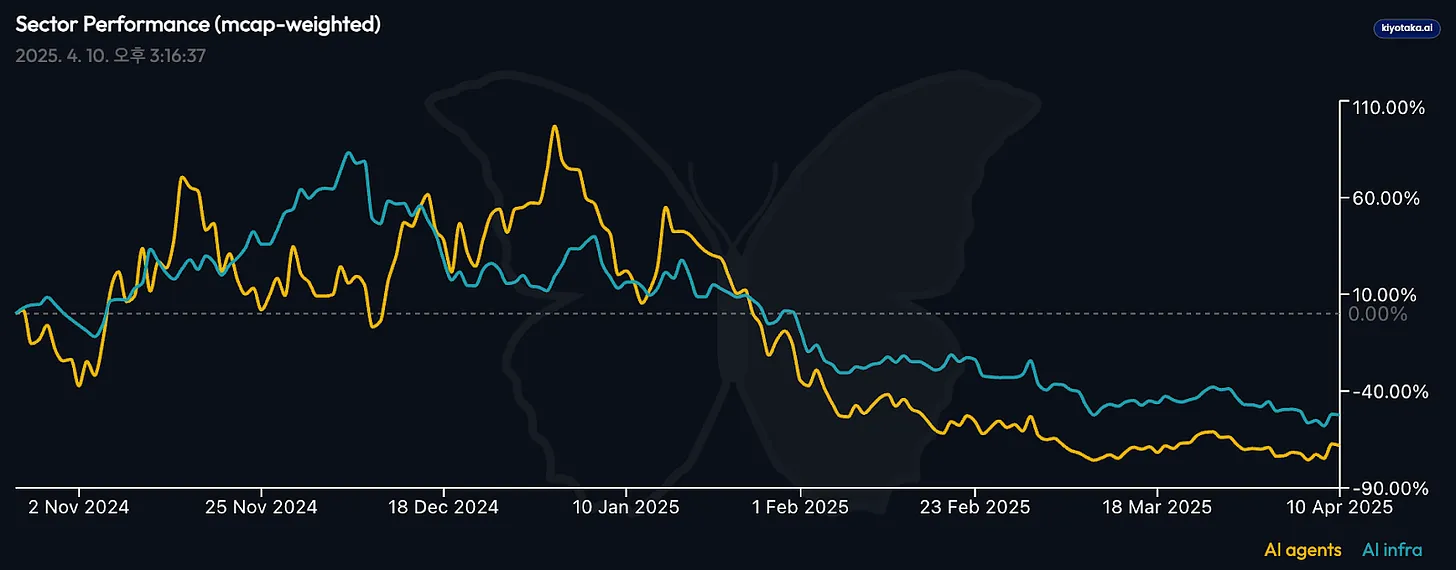
Source: Kiyotaka
The intersection of AI and blockchain has long attracted industry attention. Centralized AI systems still face challenges such as transparency, reliability, and cost predictability—areas that are often seen as potential solutions for blockchain.
Despite the explosion of the AI agent market in late 2024, most projects have only achieved surface-level integration of the two technologies. Many initiatives rely on speculative interest in cryptocurrencies for funding and exposure rather than exploring deep technical or functional synergies with Web3. As a result, valuations of many projects have fallen by more than 90% from their peak.
The reason why AI and blockchain are difficult to achieve substantial synergy lies in multiple structural problems. The most prominent one is the complexity of on-chain data processing - data is still fragmented and technology is highly volatile. If data access and utilization can be as simple as traditional systems, the industry may have achieved clearer results long ago.
This dilemma resembles a Romeo and Juliet script: two powerful technologies from different fields lack a common language or a true intersection of convergence. It is becoming increasingly clear that the industry needs an infrastructure that can bridge the gap - one that can complement the strengths of AI and blockchain and serve as a meeting point for the two.
Meeting this challenge requires cost-effective and high-performance systems that match the reliability of existing centralized tools. In this context, vector database technology, which supports most of today’s AI innovations, is becoming a key enabler.
2. Necessity of vector database
As AI applications become more popular, vector databases have emerged as a solution to the limitations of traditional database systems. These databases store complex data such as text, images, and audio by converting them into mathematical representations called "vectors." Because they retrieve data based on similarity rather than accuracy, vector databases are more in line with AI's understanding of language and context than traditional databases.
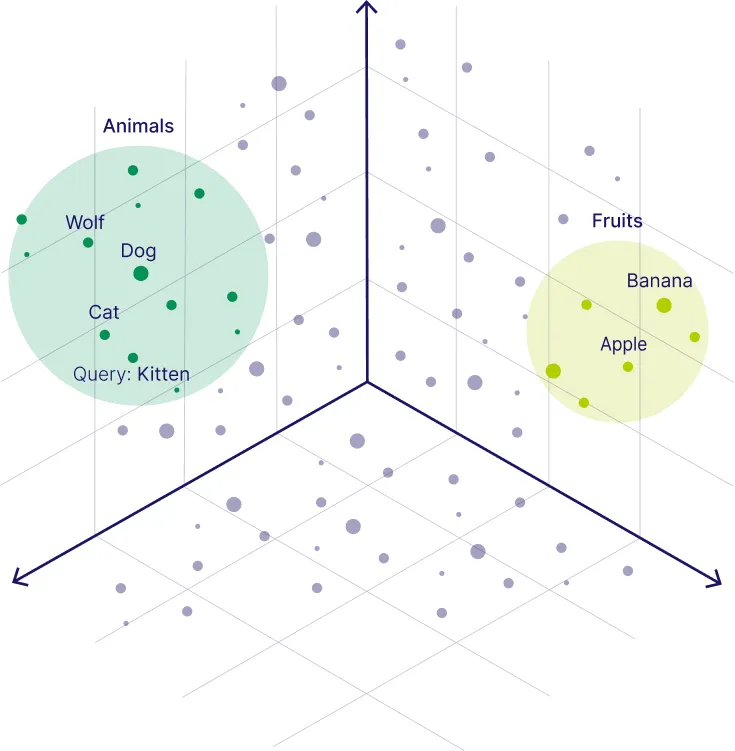
Source: weaviate
While a traditional database is like a library catalog—returning only books containing the word “kitten”—a vector database can present “cat,” “dog,” “wolf,” etc. This is because the system stores information in the form of numerical vectors, capturing relationships based on conceptual similarities rather than precise wording.
Take conversation as an example: when someone is asked, "How are you feeling today?", if they answer, "The sky is exceptionally clear," we can still understand their positive emotions - even though no explicit sentiment words are used. The vector database works in a similar way, allowing the system to interpret the underlying meaning rather than relying on direct word matching. This simulates human cognitive patterns and enables more natural and intelligent AI interactions.
In Web2, the value of vector databases has been widely recognized. Platforms such as Pinecone ($100 million), Weaviate ($50 million), Milvus ($60 million), and Chroma ($18 million) have received huge investments. In contrast, Web3 has always found it difficult to develop comparable solutions, making the integration of AI and blockchain more of a theoretical endeavor.
3. The Vision of the Chromia On-chain Vector Database
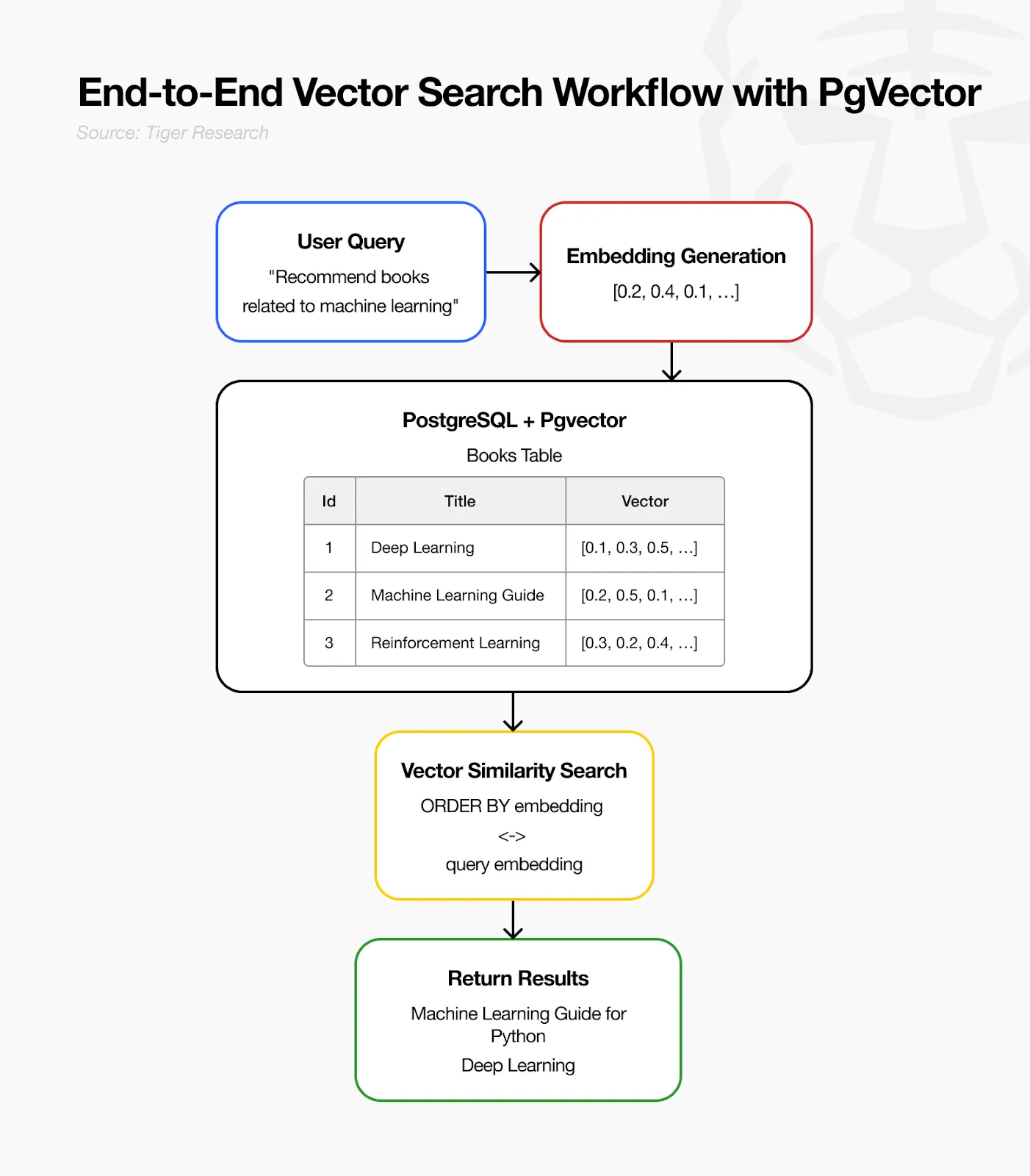
Source: Tiger Research
Chromia, a Layer 1 relational blockchain built on PostgreSQL, stands out for its structured data processing capabilities and developer-friendly environment. Relying on its relational database foundation, Chromia has begun to explore the deep integration of blockchain and AI technologies.
A recent milestone is the launch of the “Chromia extension”, which integrates PgVector, a widely used open source vector similarity search tool within the PostgreSQL database. PgVector enables efficient queries for similar text or images, providing clear utility for AI-driven applications.
PgVector has a solid foundation in the traditional technology ecosystem. Supabase, which is often regarded as an alternative to the mainstream database service Firebase, uses PgVector to support high-performance vector search. Its growing popularity on the PostgreSQL platform reflects the industry's broad confidence in the tool.
By integrating PgVector, Chromia brings vector search capabilities to Web3, aligning its infrastructure with proven standards of traditional technology stacks. This integration plays a core role in the Mimir mainnet upgrade in March 2025 and is seen as a fundamental step towards seamless AI-blockchain interoperability.
3.1 Integrated environment: complete integration of blockchain and AI
The biggest challenge for developers trying to combine blockchain and AI is complexity. Creating AI applications on existing blockchains requires a complex process of connecting to multiple external systems. For example, developers need to store data on the chain, run AI models on external servers, and build independent vector databases.
This fragmented structure leads to inefficient operations. User queries are processed off-chain, and data needs to be continuously migrated between on-chain and off-chain environments. This not only increases development time and infrastructure costs, but also creates serious security vulnerabilities - data transmission between systems increases the risk of hacker attacks and reduces overall transparency.
Chromia provides a fundamental solution by integrating the vector database directly into the blockchain. On Chromia, all processing is done on-chain: user queries are converted into vectors, and similar data is searched directly on-chain and the results are returned, achieving full-process single-environment processing.
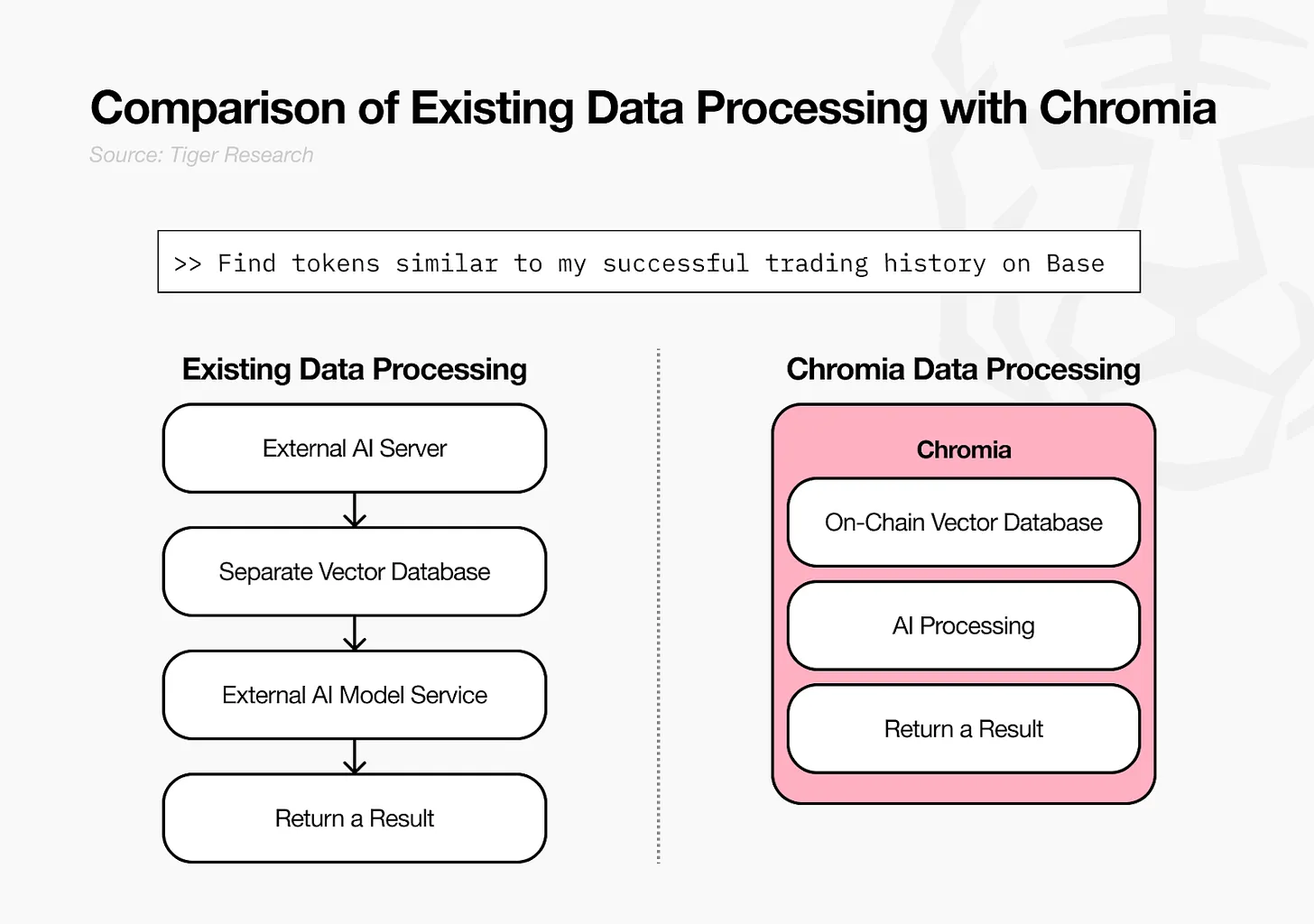
Source: Tiger Research
To use a simple analogy: in the past, developers had to manage components separately - just like buying pots, pans, blenders, and ovens to cook. Chromia simplifies the process by providing an all-in-one food processor that integrates all functions into a single system.
This integration method greatly simplifies the development process. No external services and complex connection codes are required, reducing development time and costs. In addition, all data and processing are recorded on the chain to ensure full transparency. This marks the beginning of the full integration of blockchain and AI.
3.2 Cost efficiency: Excellent price competitiveness compared to existing services
There is a common stereotype that on-chain services are "inconvenient and expensive". In particular, in the traditional blockchain model, the structural defects of each transaction generating fuel fees and the surge in congestion chain costs are significant. Cost unpredictability has become a major obstacle for enterprises to adopt blockchain solutions.
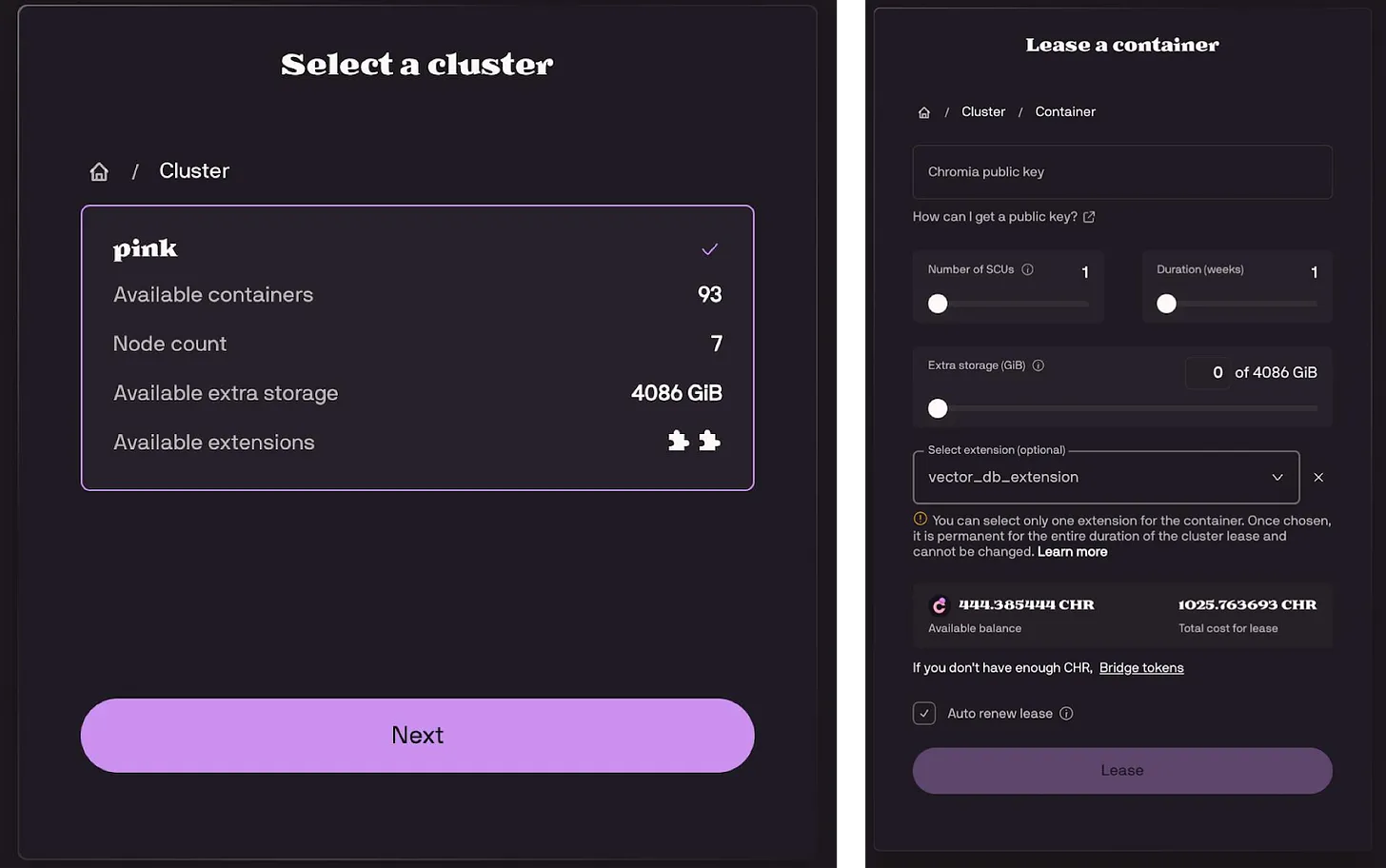
Source: Chromia
Chromia solves pain points through efficient architecture and differentiated business models. Different from the traditional blockchain fuel fee model, Chromia introduces a server computing unit (SCU) leasing system - similar to the pricing structure of AWS or Google Cloud. This instantiation model is consistent with familiar cloud service pricing and eliminates the cost fluctuations common in blockchain networks.
Specifically, users can use Chromia's native token $CHR to rent SCUs on a weekly basis. Each SCU provides 16GB of baseline storage, and costs scale linearly with usage. SCUs can be adjusted flexibly according to demand, achieving flexible and efficient resource allocation. This model integrates predictable usage pricing for Web2 services while maintaining network decentralization - greatly improving cost transparency and efficiency.
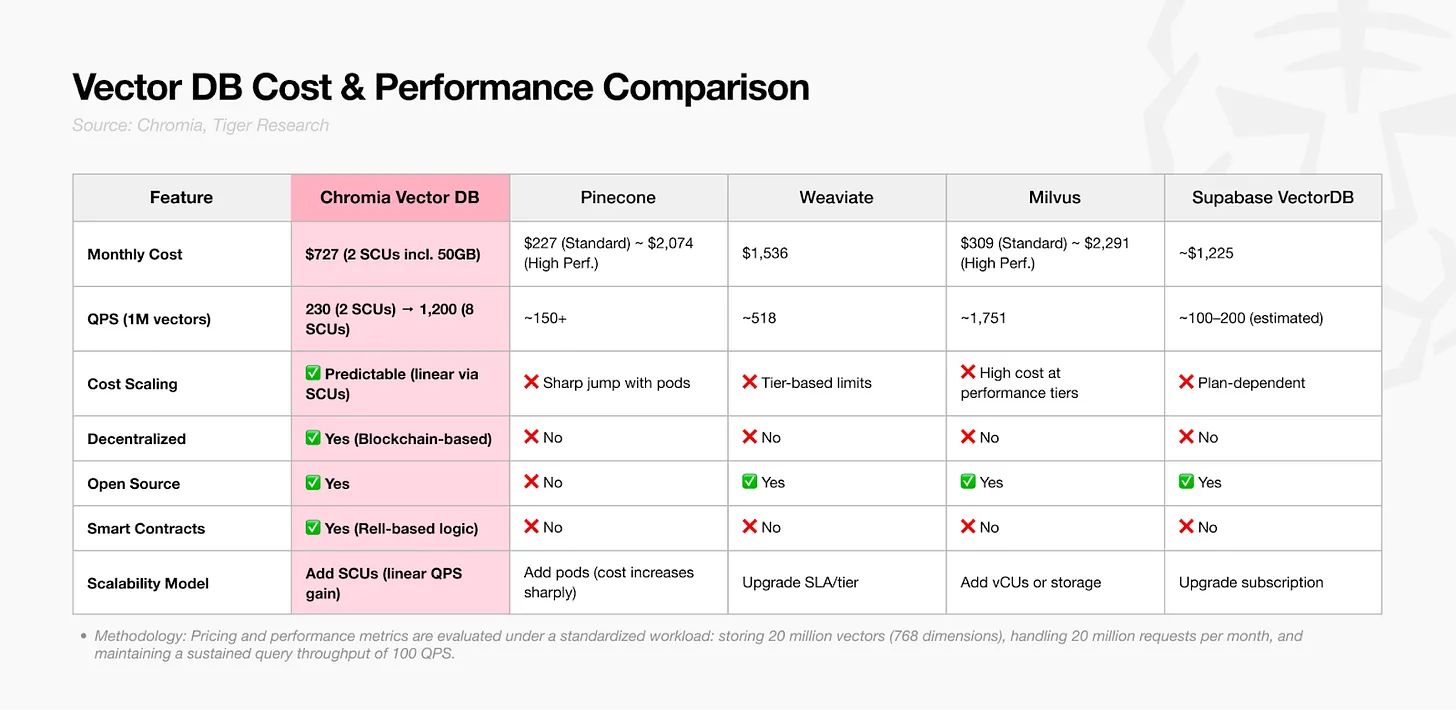
Source: Chromia, Tiger Research
The Chromia vector database further strengthens the cost advantage. According to internal benchmarks, the monthly operating cost of the database is $727 (based on 2 SCUs and 50GB of storage) - 57% lower than similar Web2 vector database solutions.
This price competitiveness stems from multiple structural efficiencies. Chromia benefits from the technical optimization of adapting PgVector to the on-chain environment, but the greater impact comes from its decentralized resource supply model. Traditional services are superimposed on AWS or GCP infrastructure with high service premiums, while Chromia directly provides computing power and storage through node operators, reducing the middle layer and related costs.
The distributed structure also improves service reliability. The parallel operation of multiple nodes makes the network naturally highly available, even if individual nodes fail. Therefore, the typical high-availability infrastructure and large support team requirements in the Web2 SaaS model are significantly reduced, which not only reduces operating costs but also enhances system resilience.
4. The beginning of the integration of blockchain and AI
Although only launched a month ago, the Chromia Vector Database has already shown early traction, with multiple innovative use cases being developed. To accelerate adoption, Chromia is actively supporting builders by providing grants to cover the cost of using the Vector Database.
These grants lower the barrier to experimentation, allowing developers to explore new ideas with less risk. Potential applications include AI-integrated DeFi services, transparent content recommendation systems, user-owned data sharing platforms, and community-driven knowledge management tools.
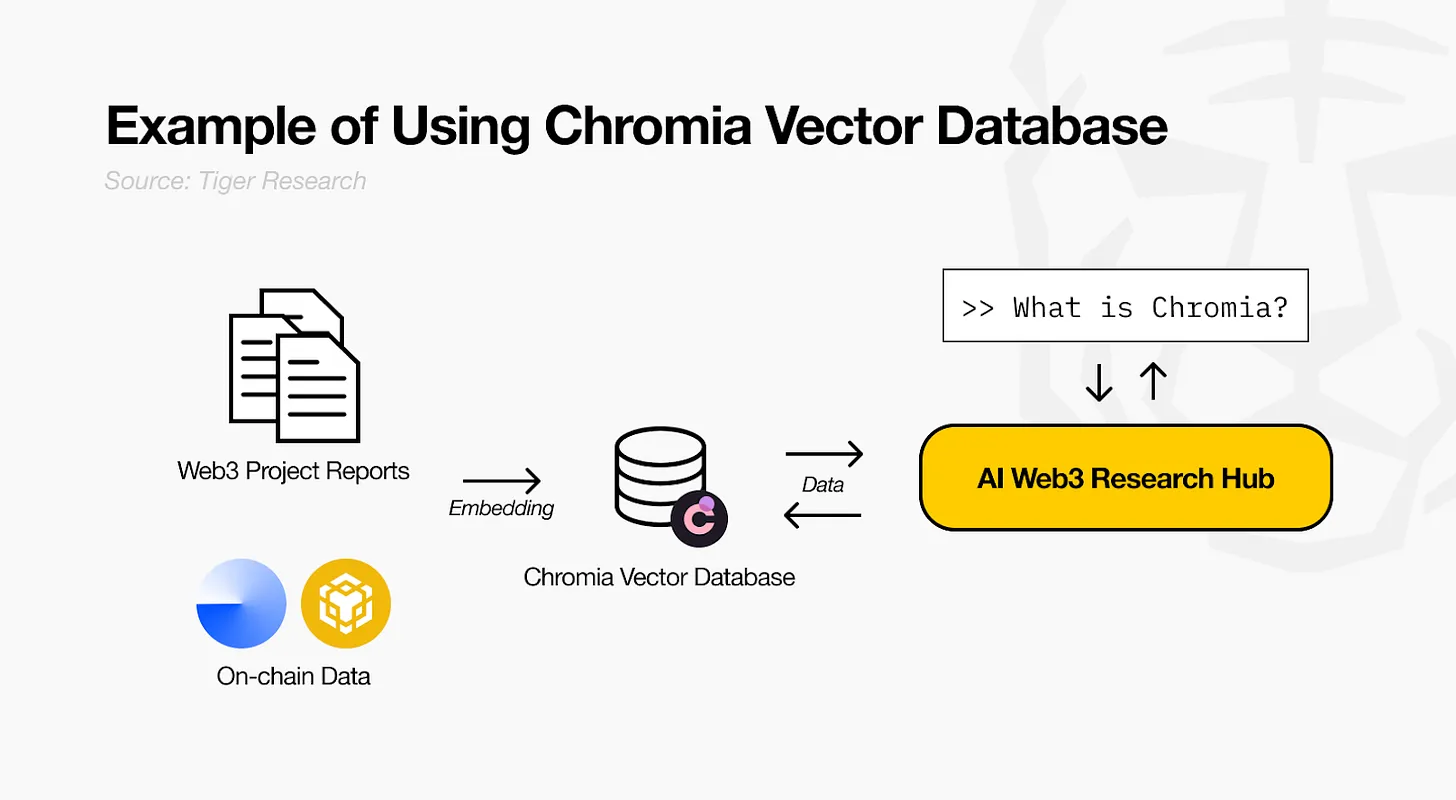
Source: Tiger Research
A hypothetical example is the "AI Web3 Research Hub" developed by Tiger Labs. The system uses Chromia infrastructure to convert research content and Web3 project chain data into vector embeddings for AI agents to provide intelligent services.
These AI agents can query on-chain data directly through the Chromia vector database, achieving significantly faster responses. Combined with Chromia's EVM indexing capabilities, the system can analyze on-chain activities such as Ethereum, BNB Chain, Base, etc. - supporting a wide range of projects. It is worth noting that the user conversation context is stored on-chain, providing a completely transparent recommendation flow for end users such as investors.
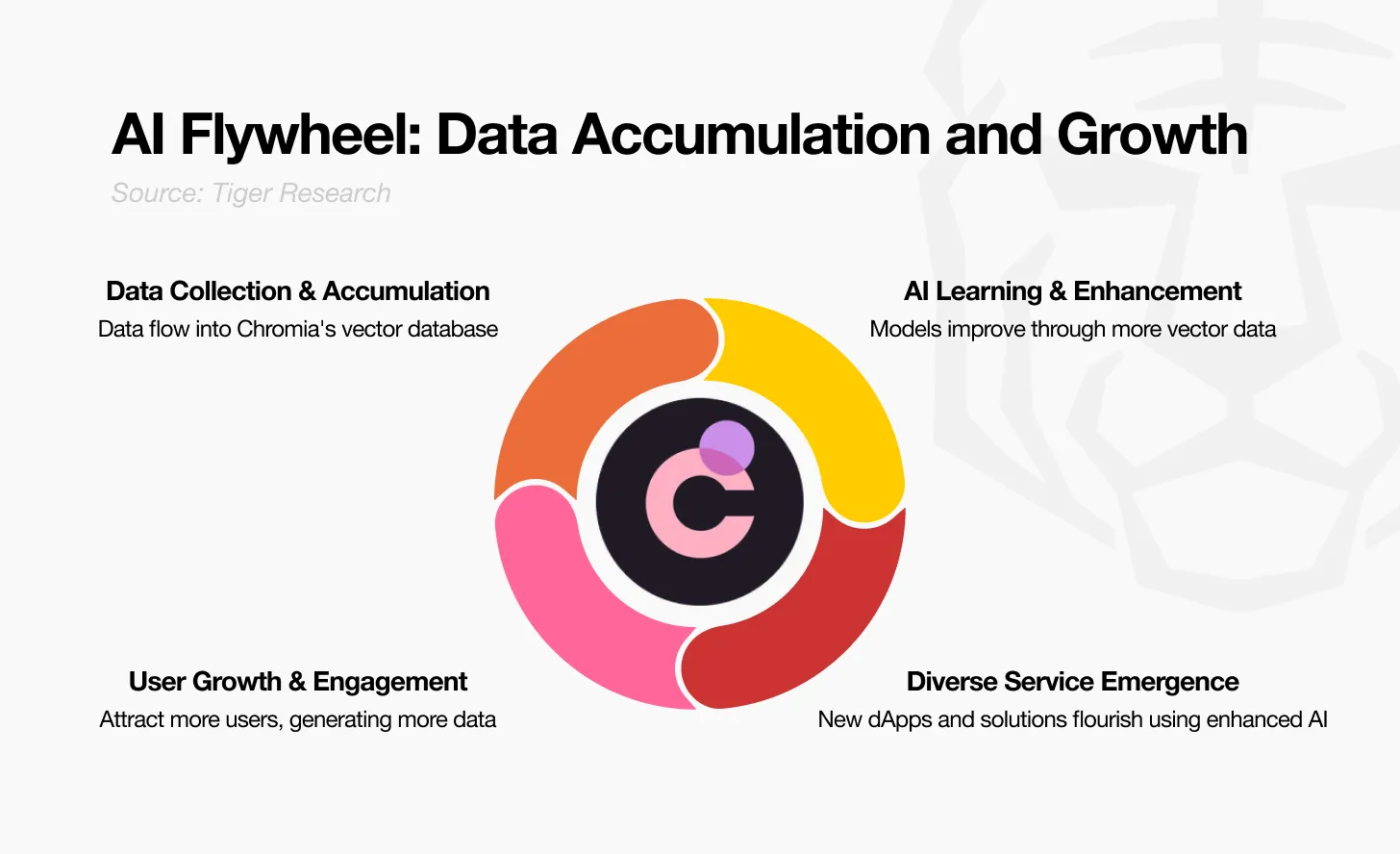
Source: Tiger Research
As diverse use cases grow, more data continues to be generated and stored in Chromia - laying the foundation for the "AI flywheel". Text, images, and transaction data from blockchain applications are stored in the Chromia database in the form of structured vectors, forming a rich AI trainable data set.
These accumulated data become the core learning materials of AI, driving continuous performance improvement. For example, AI that learns from the transaction patterns of massive users can provide more accurate and customized financial advice. These advanced AI applications attract more users by enhancing user experience, and user growth will lead to more abundant data accumulation, forming a closed loop of sustainable ecological development.
5. Chromia’s Roadmap
Following the launch of Mimir mainnet, Chromia will focus on three areas:
Enhance the EVM index of mainstream chains such as BSC, Ethereum, and Base;
Expand AI reasoning capabilities to support a wider range of models and use cases;
Expand the developer ecosystem through easier-to-use tools and infrastructure.
5.1 EVM Index Innovation
The inherent complexity of blockchain has long been a major obstacle for developers. To this end, Chromia has launched an innovative indexing solution with developers at the core, aiming to fundamentally simplify on-chain data queries. The goal is clear: to make blockchain data more accessible by significantly improving query efficiency and flexibility.
This approach represents a major shift in the way Ethereum NFT transactions are tracked. Chromia dynamically learns data patterns and structures, replacing rigid predefined query structures to identify the most efficient information retrieval paths. Game developers can instantly analyze on-chain item transaction history, and DeFi projects can quickly track complex transaction flows.
5.2 AI Reasoning Capability Expansion
The aforementioned progress in data indexing lays the foundation for Chromia to expand its AI reasoning capabilities. The project has successfully launched the first AI reasoning extension on the testnet, focusing on supporting open source AI models. It is worth noting that the introduction of the Python client has greatly reduced the difficulty of integrating machine learning models in the Chromia environment.
This development goes beyond technical optimization and reflects a strategic alignment with the fast pace of AI model innovation. By supporting the running of an increasingly diverse range of powerful AI models directly on vendor nodes, Chromia aims to push the boundaries of distributed AI learning and reasoning.
5.3 Developer Ecosystem Expansion Strategy
Chromia is actively building collaborations to unlock the full potential of vector database technology, with a focus on AI-driven application development. These efforts are designed to increase network utility and demand.
The company is targeting high-impact areas such as AI research agents, decentralized recommendation systems, context-aware text search, and semantic similarity search. The plan goes beyond technical support to create a platform where developers can build real user value applications. Previously enhanced data indexing and AI reasoning capabilities are expected to become the core engine for the development of these applications.
6. Chromia’s Vision and Market Challenges
Chromia's on-chain vector database makes it a leading competitor in the blockchain-AI convergence space. Its innovative approach - directly integrating the vector database on the chain - has not been achieved in other ecosystems, highlighting a clear technical advantage.
The platform's cloud-based SCU leasing model also introduces an attractive paradigm shift for developers accustomed to the gas fee system. This predictable and optimized cost structure is particularly suitable for large-scale AI applications and constitutes a key differentiation point. It is worth noting that the cost of use is about 57% lower than that of Web2 vector database services, which significantly enhances Chromia's market competitiveness.
Despite this, Chromia faces key challenges - especially market awareness and ecosystem growth. It is crucial to communicate its complex innovations such as its native programming language (Rell) and on-chain AI integration to developers and enterprises. Staying ahead requires continued technical development and ecosystem expansion, especially when other blockchain platforms begin to target similar use cases.
Long-term success depends on validating real use cases and ensuring the sustainability of the token economic model. The impact of the SCU leasing model on the long-term value of the token, an effective developer adoption strategy, and the creation of substantive commercial use cases will be decisive factors in Chromia's future development.
Chromia has established an early leadership position in the emerging Web3-AI convergence field. However, turning technological differences into lasting market value requires continued progress in infrastructure, ecology, and communication. The next 12-24 months will be critical in shaping Chromia's long-term trajectory.















